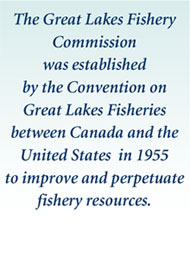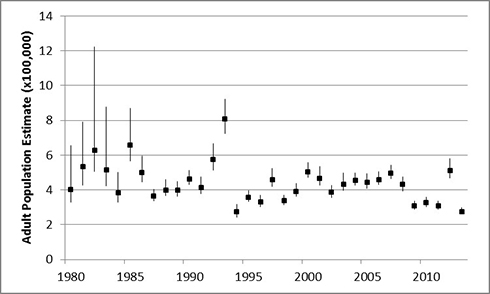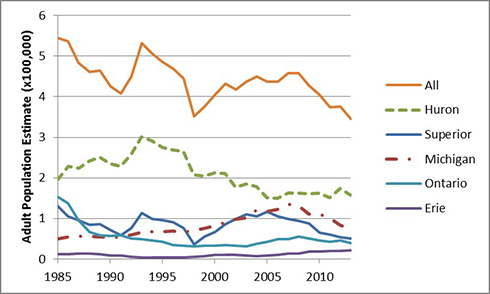

GLFC Celebrates Passage of the Great Lakes Fishery Research Reauthorization Act.

USGS scientist takes aim at Great Lakes invaders
Rising Higher: A Research Lab Built from the Ground Up - Part 2
Great Lakes Researchers Go Down Under
Rising Higher: A Research Lab Built from the Ground Up - Part 1
A Monograph on Ciscoes of the Laurentian Great Lakes and Lake Nipigon
WATCH: Acoustic Telemetry Provides In-Depth Look into Fish Behavior
Eel-Ladder Style Traps: A New Lamprey Control Tool
A Lampricide Treatment: Up-Close
Lamprey Nativeness Claims Annulled by Commission's Eshenroder
A Population at the Edge: American Eel Declining at the Extremes
Celebrating 60 Years of Successful Sea Lamprey Control, Science, and Cross-Border Collaboration!
Great Lakes Scientists Use Acoustic Telemetry to Reveal the Secret Lives of Fish
Hammond Bay Biological Station: The Nexus for Research and Restoration on the Great Lakes
Big Consequences of Small Invaders
New Sea Lamprey Estimates Suggest a Dramatically Decreased Population
Conducting Research through Cooperative Partnerships: The PERM Agreement
Living on the Edge: A Closer Look at Coastal Communities
Asian Carp: The War Isn't Over
Managing the Lake Huron Fishery
Understanding Sea Lamprey: Mapping the Genome and Identifying Pheromones

- New Sea Lamprey Estimates Suggest a Dramatically Decreased Population
- It's Getting Hot in Here!
- Big Consequences of Small Invaders
- Hammond Bay Biological Station: The Nexus for Research and Restoration on the Great Lakes
New Sea Lamprey Estimates Suggest a Dramatically Decreased Population
Each year, the Great Lakes Fishery Commission evaluates the success of the sea lamprey control program by estimating the sea lamprey population in each lake. These estimates come from on-the-ground assessment and models.
Recently released news is quite encouraging: the basin-wide sea lamprey population declined by 50% between 2012 and 2013. Although it is too early to determine the strength of this trend, the decrease is likely due to major control initiatives during the past several years.
2013 Adult Sea Lamprey Abundance Estimates
The annual estimate of the adult sea lamprey population is derived from a model that was developed in 2003 and improved during the ensuing years. Estimates are measured against the abundance targets set for each lake to determine the level of required sea lamprey control. The models differ for each lake, taking into account specific attributes like the sea lamprey treatment cycle and the number of lamprey-producing streams.
The 2013 estimates for sea lamprey abundances indicate that populations are within the target range for lakes Superior, Michigan, and Ontario. Populations remain above target in lakes Huron and Erie, yet they are trending in the right direction, toward target levels. Perhaps most notable is that the total basin-wide abundance has decreased from last year by nearly half. The total abundance of adult sea lampreys across the entire Great Lakes basin decreased from an estimated 511,000 during 2012 to an estimated 275,000 during 2013.

Annual, lake-wide adult population estimates with bias-corrected 95% confidence intervals for all lakes combined through 2013. FIGURE: J. BARBER, USFWS; G. BRAVENER, DFO; J. ADAMS, GLFC/USGS
Key Areas of Concern: Lakes Huron and Erie
Lake Huron
Sea lampreys are found in more than 200 streams throughout the Great Lakes basin, yet more than half of
the 275,000 adult sea lampreys reside in just nineteen streams. Ten of these nineteen streams are tributaries to Lake Huron and
account for an estimated 32% of the basin-wide total of adult sea lamprey. Indeed, Lake Huron presents a unique challenge to sea
lamprey control because it is fed by some of the most prolific sea lamprey producing tributaries in the basin.
Due in large part to these major sea lamprey producing tributaries, sea lamprey abundances in Lake Huron have been above target for many years. To remedy the problem, sea lamprey control experts initiated a large-scale effort to treat the North Channel area of Lake Huron (including the St. Marys River) during 2010-2011, along with geographically expanded treatments in the northern parts of lakes Huron and Michigan in 2012 and 2013. While this increased treatment effort successfully reduced larval sea lampreys in the St. Marys River to an all-time low, the adult sea lamprey population remained frustratingly high. The good news is, the latest estimates suggest a trend in the right direction, which can likely be attributed to the increased treatments during the past three years.
Lake Erie
Despite intensified treatments over the past five years, Lake Erie sea lamprey
abundances remain quite high. Record sea lamprey abundance was recorded in 2009 and, for the fourth consecutive year, in 2013, adult
sea lamprey numbers in Lake Erie exceeded pre-control populations. The sea lamprey control program has undertaken several
initiatives to determine the source of Lake Erie sea lampreys, including extensive surveys of Lake Erie tributaries, preliminary
evaluation of the St. Clair and Detroit Rivers (known as the Huron-Erie Corridor) as a possible new source of sea lampreys, and
interviews with U.S. commercial and charter fishers. Results from trapping efforts in the Huron-Erie Corridor in 2012 and
2013 reinforced suspicions that this system may be a significant source of sea lampreys in Lake Erie; investigations will continue
in coming years.

Five-year running means of annual, lake-wide adult population estimates for each Great Lake and all lakes combined, 1980-2013. FIGURE: J. BARBER, USFWS; G. BRAVENER, DFO; J. ADAMS, GLFC/USGS
Future
While the latest sea lamprey estimates are good news, the commission is cautious about overstating the results, since the large single-year decline in abundance this year follows an increase in abundance last year. The commission is hopeful that the estimated reduction in abundance can be attributed in large part to the focused, increased treatment program. A more definitive judgment will be reserved until abundance estimates for 2014 are available.
When sea lamprey populations are on the rise, the commission dedicates as many resources as possible to combat these noxious predators. The reduction in sea lamprey abundances has been possible because of the Great Lakes Congressional and Parliamentary delegations' strong support for the commission's work. The commission's ability to deliver sea lamprey control is directly related to the funding it receives from the governments. For fiscal year 2013 (which ended on September 30, 2013), the commission received a 9.8% reduction in its budget, with additional cuts looming for 2014. The commission's ability to remain within target or to reach target in Lakes Huron and Erie is in serious jeopardy if funding persists at the current level.
For more information about this issue, contact:
Marc Gaden at 734-669-3012


Sea lamprey attach to fish and feed on their blood and body fluids. Each lamprey kills about 40 pounds of fish in its lifetime. PHOTOS: T. LAWRENCE, GLFC (TOP) AND E. STOPKE (BOTTOM)
.jpg)
.jpg)
Sea lamprey control occurs in streams and tributaries. Larval lamprey are targeted with lampricides and adult lamprey are removed via traps. PHOTOS: T. LAWRENCE, GLFC (TOP) AND A. MUIR, GLFC (BOTTOM)


